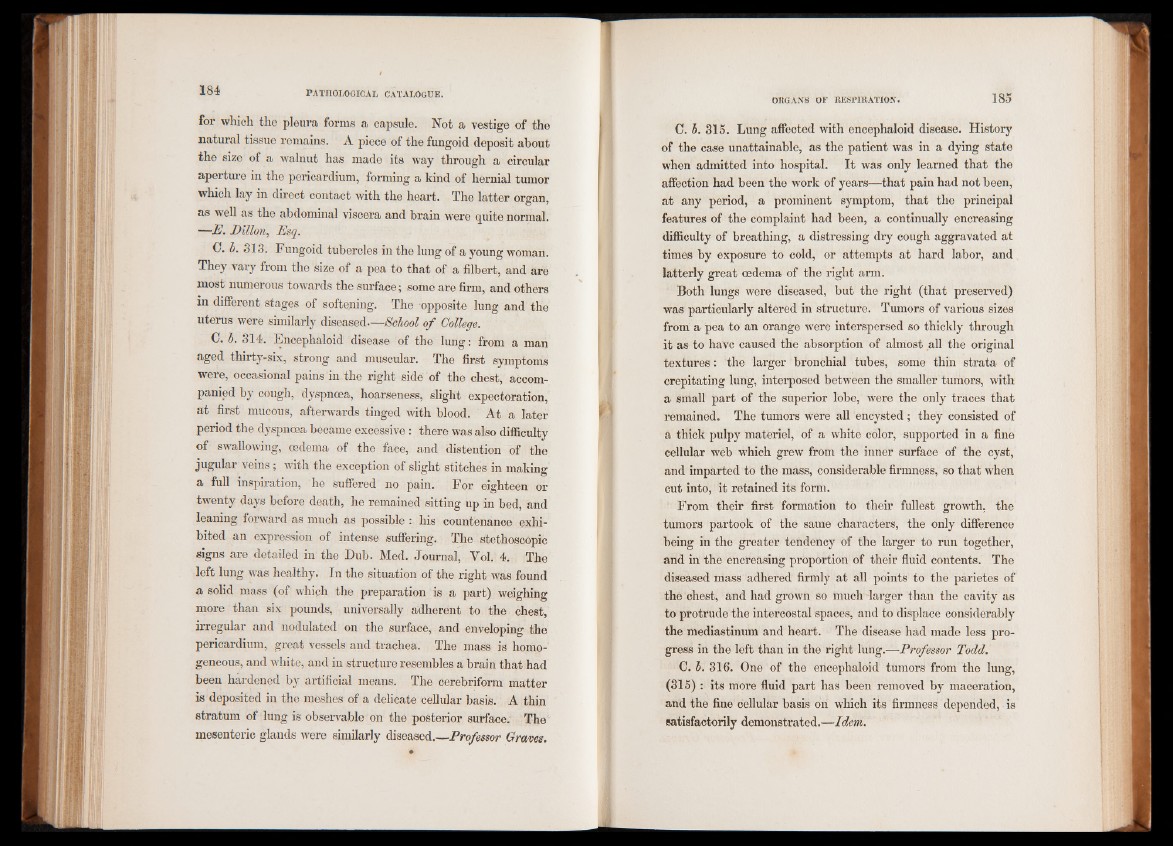
for which the pleura forms a capsule. Not a vestige of the
natural tissue remains. A piece of the fungoid deposit about
the size of a walnut has made its way through a circular
aperture in the pericardium, forming a kind of hernial tumor
which lay in direct contact with the heart. The latter organ,
as well as the abdominal viscera and brain were quite normal.
—E. Dillon, Esq.
G. b. 313. Fungoid tubercles in the lung of a young woman.
They vary from the size of a pea to that of a filbert, and are
most numerous towards the surface; some are firm, and others
in different stages of softening. The opposite lung and the
uterus were similarly diseased— School of College.
C. b. 314. Eneephaloid disease of the lung: from a man
aged thirty-six, strong and muscular. The first symptoms
were, occasional pains in the right side of the chest, accompanied
by cough, dyspnoea, hoarseness, slight expectoration,
at first mucous, afterwards tinged with blood. At a later
period the dyspnoea became excessive : there was also difficulty
of swallowing, oedema of the face, and distention of the
jugular veins; with the exception of slight stitches in making
a full inspiration, he suffered no pain. For eighteen or
twenty days before death, he remained sitting up in bed, and
leaning forward as much as possible : his countenance exhibited
an expression of intense suffering. The stethoscopic
signs are detailed in the Dub. Med. Journal, Yol. 4 . The
left lung was healthy. In the situation of the right was found
a solid mass (of whiph the preparation is a part) weighing
more than six pounds, universally adherent to the chest,
irregular and nodulated on the surface, and enveloping the
pericardium, great vessels and trachea. The mass is homogeneous,
and white, and in structure resembles a brain that had
been hardened by artificial means. The cerebriform matter
is deposited in the meshes of a delicate cellular basis. A thin
stratum of lung is observable on the posterior surface. The
mesenteric glands were similarly diseased.—Professor Graves.
C. b. 315. Lung affected with eneephaloid disease. History
of the case unattainable, as the patient was in a dying state
when admitted into hospital. It was only learned that the
affection had been the work of years—that pain had not been,
at any period, a prominent symptom, that the principal
features of the complaint had been, a continually encreasing
difficulty of breathing, a distressing dry cough aggravated at
times by exposure to cold, or attempts at hard labor, and
latterly great oedema of the right arm.
Both lungs were diseased, but the right (that preserved)
was particularly altered in structure. Tumors of various sizes
from a pea to an orange were interspersed so thickly through
it as to have caused the absorption of almost all the original
textures: the larger bronchial tubes, some thin strata of
crepitating lung, interposed between the smaller tumors, with
a Small part of the superior lobe, were the only traces that
remained. The tumors were all encysted; they consisted of
a thick pulpy materiel, of a white color, supported in a fine
cellular web which grew from the inner surface of the cyst,
and imparted to the mass, considerable firmness, so that when
cut into, it retained its form.
From their first formation to their fullest growth, the
tumors partook of the same characters, the only difference
being in the greater tendency of the larger to run together,
and in the encreasing proportion of their fluid contents. The
diseased mass adhered firmly at all points to the parietes of
the chest, and had grown so much larger than the cavity as
to protrude the intercostal spaces, and to displace considerably
the mediastinum and heart. The disease had made less progress
in the left than in the right lung.—Professor Todd.
C. b. 316. One of the eneephaloid tumors from the lung,
(315) : its more fluid part has been removed by maceration,
and the fine cellular basis on which its firmness depended, is
satisfactorily demonstrated.—Idem.